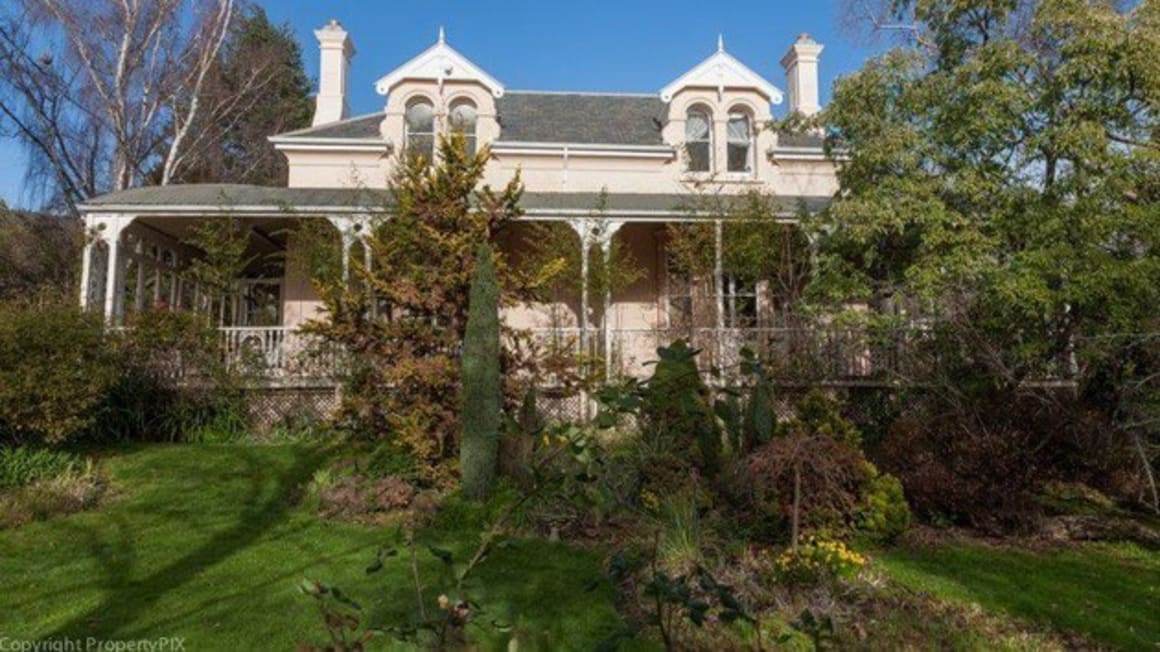Historical landmark homes for sale in Tasmania

A seven-bedroom 1884 house in Sandy Bay, Tasmania, has all the makings of a hidden gem. From the front, it's unassuming, and had the 'for sale' sign not revealed the size of the property (seven bedrooms, three bathrooms, three car spaces), it would have been passed by unseen.
7 bedroom 1884 Henry Hunter designed beauty in Sandy Bay! #propertyobserving @propertyobs pic.twitter.com/TJojIcevS7
— Jennifer Duke (@JennieDuke) November 3, 2013
It's a difficult property to appreciate without seeing it in the flesh. Largely hidden behind trees and shrubbery, the Knight Frank listing shows it has something of a 'secret garden' feel, combined with views of Lower Sandy Bay.
The 2 Mawhera Avenue corner block house (pictured below) does seem to have confusion over the number of bedrooms. While the sign notes it has seven bedrooms, the online listing says five, and the description says "six upstairs". With so many rooms, it's not surprising that there may be some confusion over what each of their functions are.
{yoogallery src=[images/stories/2013/11/07/sand]}
With a wrap verandah, bay windows, flower gardens, original swimming pool, servants bell system, butler's pantry, maid quarters, french doors, fireplaces, window seats, a grand ballroom and a library, there's not much that you won't find.
However, it does need substantial renovations, and with a potential $1.5 million plus price tag, according to a price guide provided by the agent via email (who had previously noted $1.1 million), you'll need to be ready for a substantial outlay.
Sandy Bay is one of the most expensive and prestigious areas in Tasmania, with a median house price of $590,099 (RP Data). Property Observer previously covered a stunning 1900s Sandy Bay waterfront property that was listed for $2.25 million plus in 2011.
Attempts to sell this Mawhera Avenue 2,434 square metre home has previously seen a call out for expressions of interest over $2,000,000, with a prior attempt at listing the property on 29 April 2010. Currently, RP Data notes that the property has been on the market for 210 days, having earlier been listed with a different agency.
It was designed by Nottingham, England architect, Henry Hunter, whose story just adds to the historical feel of the property.
Having migrated to South Australia in 1848 as a 16 year old, Hunter then went to Bendigo goldfields to help pay his family's debts in Adelaide, the Australian Dictionary of Biography notes.
He later worked at Port Esperance in Tasmania in the timber trade, before moving to Hobart where, in 1856, he began to practise as an architect.
In 1888, The Mercury referred to Hunter's leaving of Hobart to head to Queensland after 37 years in residence. The paper referred to him as a "gentleman who has been closely associated with the progress of this city". You can see how much this home is typical of his design style based on the images stored here.
In more recent times, he has been referred to as one of the most prominent Tasmanian architects in the mid-19th Century. He also designed Hobart Town Hall, the Royal Insurance Building, the museum and both cathedrals.
He is also responsible for this landmark property, for buyers looking in the $1,800,000 plus price range, 289 Davey Street South Hobart (pictured below) listed by Charlotte Peterswald For Property Sales - Battery Point. The four-bedroom, two-bathroom home was designed for one of Hobart's early Lord Mayors.
{yoogallery src=[images/stories/2013/11/08/hob]}
The 2,135 square metre home, called Ashleigh, was built circa 1887 and also has the wide verandah we see in the Sandy Bay property above and is marketed as "one of Hobart's most outstanding properties".
The property is, by appearance, in better condition than its Sandy Bay counterpart, and may achieve a better price despite the median house price in South Hobart sitting at $405,000.